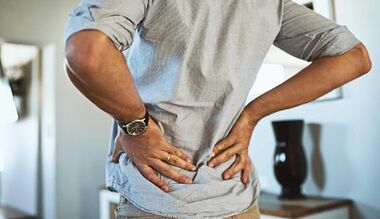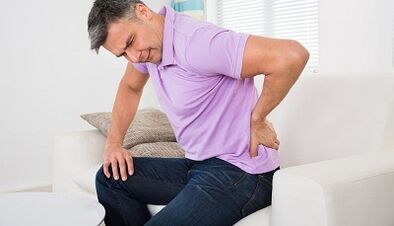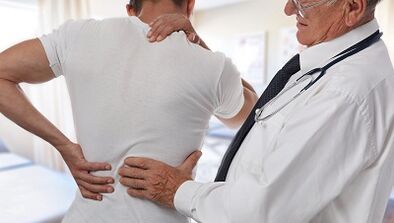
Back pain can occur at any age, but usually occur between 35 and 55 years.The pain in the spine is related to the way the bones, muscles, discs, ligaments, tendons and our nerves work.
The pain in the spine can be caused by problems with the vertebra, the discs between them, ligaments around the spine and disc, spinal cord and nerves, back muscles, internal organs in the abdomen and pelvis.In addition, the diseases of the aorta, the tumors in the chest and the upper back of the back may be the cause of the upper back pain.
Risk factors
The presence of risk factors increases the ability to develop a state.For example, obesity significantly increases the risk of diabetes in the second type.
The following factors are related to the increased risk of back pain.
- Office work;
- work related to continuous stress;
- Pregnancy - Pregnant women often suffer from pain in the spine;
- Sedentary lifestyle;
- year old;
- depression;
- Obesity/excess weight;
- smoke;
- heavy physical exercises;
- Heavy physical labor.
Signs and symptoms of back pain
Symptoms are what the patient feels, while the doctor may notice signs.For example, pain is a symptom, while rash is a sign.
The main symptom of pain in the spine is pain in any part of the back.Sometimes the pain extends to the buttocks and legs or the shoulders and arms.
You must contact the doctor immediately if the pain in the spine comes with any of the following signs:
- Losing weight;
- High temperature (fever);
- Back pain is not relieved after rest;
- painful;
- Pain lowered under the knee;
- the presence of fresh spinal injury;
- No urine control (even a small part);
- Difficulties with urination - urine is difficult;
- Fertilizer - loss of control for defecation;
- paralysis in the field of genitals;
- anus;
- Paralysis in buttocks.

Applicable to an expert's advice if you are one of these groups:
- People under 22 years of age and older over 55 years old;
- Patients taking steroids for several months;
- patients with cancer;
- Patients who had cancer;
- Patients have low immunity.
Causes of back pain
Human spine is a complex structure that includes muscles, ligaments, tendons, discs and bones.The discs are placed between each vertebra pair and the function is the shock absorption of friction.Problems with any of these components can lead to pain in the spine.In some cases, the cause of the pain cannot be set.
Lengthen
The most common causes of the pain in the spine are:
- prolonged muscles;
- prolonged ligament;
- Lift a heavy object in the wrong position;
- Lift an object too heavy;
- The result of a sharp and awkward motion;
- muscle spasm.
Structural problem
The following structural problems can lead to pain in the spine:
- Expert of Intervertebral disc.The rupture of the outer shell of the disk leads to the bulging of its internal content to the outside.This can lead to a pinch of nerve and the result is painful;
- The hernia of Intervertebral disc- Stabbing into the inner content of the large size disk;
- Sciatica- Acute and shooting pain, radiating buttocks and backs of the legs caused by protruding or herniated disc, compressing nerves;
- arthritis- Patients with osteoarthritis often have problems with the joints of the thigh, lumbar spine, knee and hands.In some cases, spinal stenosis may occur, because the space around the spinal cord is narrowed;
- Abnormal bend of the spine- If the spine is unusually bent, the patient is more likely to suffer from pain in the spine.An example of an abnormal bend is scoliosis, in which the spine is curved to one side;
- Osteoporosis- Bone, including vertebrae, becomes fragile and porous, leading to an increase in their fragility.

Here are some other causes of the spine pain:
- Ponytail syndrome- Ponytail is a bunch of nerve roots where the spinal cord is branched.People with a ponytail syndrome feels in the lumbar spine and buttocks.It is also possible to lose the sensitivity of the buttocks, genitals, thighs.Sometimes people with ponytail syndrome have urine and/or fecal;
- Spine cancer- The tumor in the spine can squeeze nerves, leading to pain;
- Spine infection- If the patient has a high body temperature, and there is also a hot area in the back, this may indicate the infection of the spine;
- Other infections- Inflammation of pelvic organs in women, as well as bladder and kidney infections can also cause back pain;
- Sleep disorder- People with sleep disorders often have pain in the spine related to population in general;
- Shingles- Infections can affect nerves;
- The mattress is not suitable- If the mattress does not support some parts of the body and does not guarantee the even position of the back, there is a risk of pain in the spine.
In addition, the cause of pain in the spine may be some movements or body positions, such as long -lasting drivers, cough, etc.
What to do when it comes back to pain
If you have pain in the spine for a few days, the following tips will help you reduce pain and discomfort and accelerate recovery:

- Maintain the operation as possible;
- If necessary, use painkillers -count -count;
- Use hot and cold compressors.A bottle of hot water and a frozen vegetable bag will be done.
Despite the fact that it is difficult to be an optimist when you have pain, try not to lose your heart.This will accelerate the recovery process.
With prolonged pain in the spine, not passing within six weeks, you need to consult a doctor.The doctor will compile a medical history, conduct a test and, if necessary, will direct it into additional studies.The doctor may prescribe X -ray in case of suspicion of a problem with the skeletal system or osteoarthritis, CT (computerized tomography) or MRI (magnetic resonance tomography) in the event of an Intervertebral hernia or any other problem related to soft tissue or nerves.In such a situation, MRI is the best choice.The doctor may also recommend handing some tests in the laboratory or measuring the electrical activity of the nerves (EMG).
After the diagnosis, the doctor prescribed treatment.In most cases, there is a conservative enough treatment, which may include:
- Special exercises;
- acupressure;
- expand the spine;
- Massage.
In serious cases, the question about the activity may be posed.The surgeon will help you choose the appropriate method, and also advise on possible complications.Some time after surgery, the college treatment of the spine is recommended.Remember that the activities of the spine are quite dangerous, because the operating area is located in the vicinity of the nerves.















































